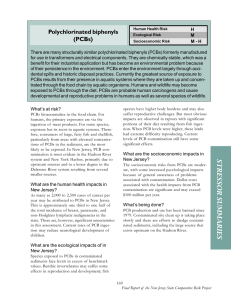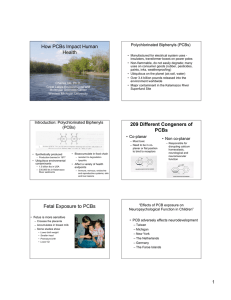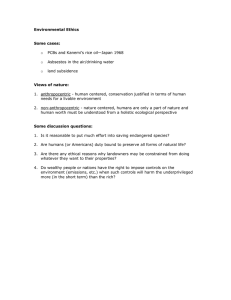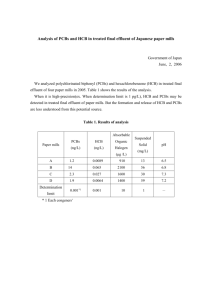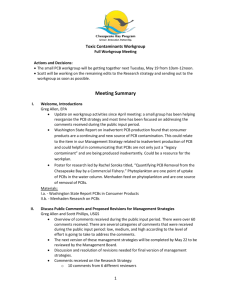Fluorescent Light Fixtures and PCBs
advertisement
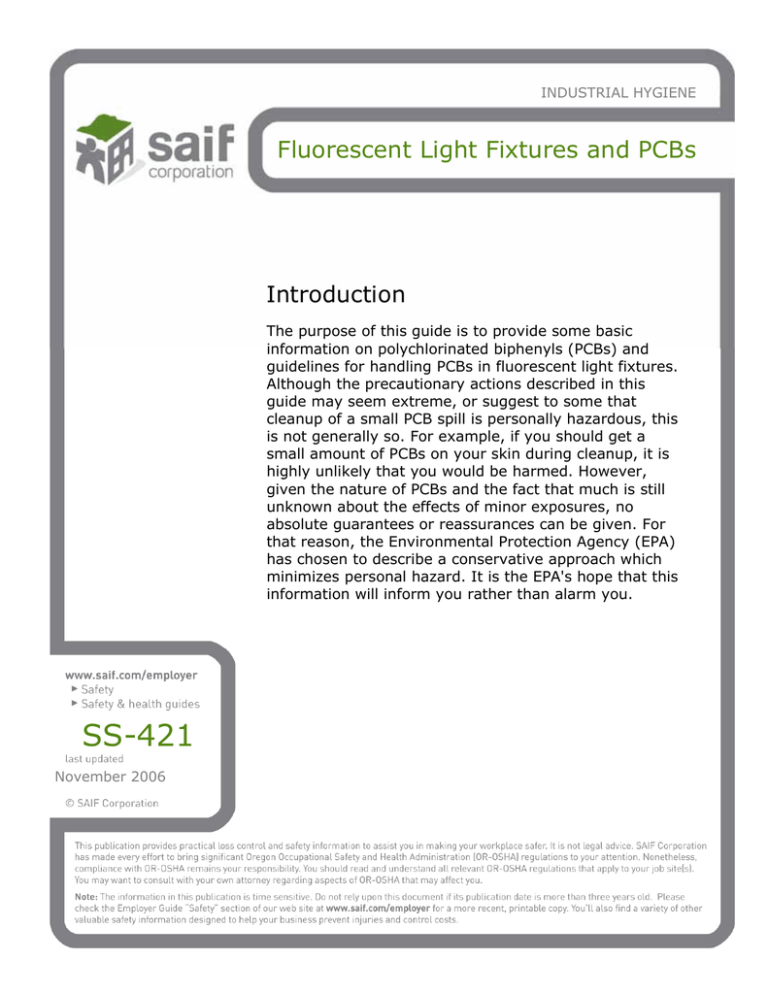
INDUSTRIAL HYGIENE Fluorescent Light Fixtures and PCBs Resources and information for developing Patient handling programs in health care Introduction The purpose of this guide is to provide some basic information on polychlorinated biphenyls (PCBs) and guidelines for handling PCBs in fluorescent light fixtures. Although the precautionary actions described in this guide may seem extreme, or suggest to some that cleanup of a small PCB spill is personally hazardous, this is not generally so. For example, if you should get a small amount of PCBs on your skin during cleanup, it is highly unlikely that you would be harmed. However, given the nature of PCBs and the fact that much is still unknown about the effects of minor exposures, no absolute guarantees or reassurances can be given. For that reason, the Environmental Protection Agency (EPA) has chosen to describe a conservative approach which minimizes personal hazard. It is the EPA's hope that this information will inform you rather than alarm you. SS-421 November 2006 Industrial Hygiene Fluorescent Light Fixtures and PCBs www.saif.com What are PCBs? PCBs (polychlorinated biphenyls) belong to a broad family of organic chemicals known as chlorinated hydrocarbons. PCBs are produced by the combination of one or more chlorine atoms and a biphenyl molecule. Virtually all PCBs in existence today have been synthetically manufactured. PCBs range in consistency from heavy oily liquids to waxy solids. Prior to 1979, PCBs were widely used in electrical equipment such as transformers, capacitators, switches and voltage regulators for their "cooling" properties because they do not readily burn or conduct electricity and only boil at high temperatures. Also, PCBs do not readily react with other chemicals. They were also used in mining equipment, heat transfer and hydraulic systems, carbonless copy paper, pigments and microscopy mounting media. Why are PCBs Harmful? When released into the environment, PCBs do not easily break apart and form new chemical arrangements (i.e., they are not readily biodegradable). Instead, they persist for many years, bioaccumulate and bioconcentrate in organisms. Laboratory data show that PCBs cause cancer in animals. Although there are no actual data showing that PCBs cause cancer in humans, the EPA's policy is to consider any animal carcinogen a possible human carcinogen. Animal studies show adverse reproductive and developmental effects from repeated exposure to PCBs. In addition, it has been shown that PCBs are toxic to fish at very low levels of exposure. The survival rate and the reproductive success of fish can be adversely affected by the presence of PCBs. The EPA believes there may be similar cause for concern when humans are exposed to large doses of PCBs. Exposure to PCBs can cause chloracne (a painful disfiguring skin ailment), liver damage, nausea, dizziness, eye irritation and bronchitis. Note: Liver damage can occur from dermal contact and inhalation, not just ingestion. Most PCBs are readily absorbed through the skin. How Does the EPA Regulate PCBs? The EPA regulates PCBs through rules issued pursuant to the federal Toxic Substances Control Act of 1976 (TSCA). These regulations generally control the use, marking, storage, records and disposal of PCBs. There are millions of pieces of equipment in operation in the U.S. which were manufactured prior to these regulations and which contain PCBs. Small Capacitors in Fluorescent Light Ballasts Light ballasts are the primary electric components of fluorescent light fixtures and are generally located within the fixture under a metal cover plate. The ballast units are generally composed of a transformer to reduce the incoming voltage, a small capacitator (which may contain PCBs), and possibly a thermal cut-off switch and/or safety fuse. These components are surrounded by a tar-like substance that is designed to muffle the noise that is inherent in the operation of the ballast. © SAIF Corporation Page 2 of 5 SS-421 November 2006 Industrial Hygiene Fluorescent Light Fixtures and PCBs www.saif.com This substance covers the small capacitator. When a ballast unit fails, excessive heat can be generated which will melt or burn the tar material, creating a characteristic foul odor. In considering causes of ballast failure, some privately conducted tests have indicated that operation of power-saving lamps with a standard ballast or standard lamps with a power-saving ballast tends to significantly increase the ballast operating temperature and decrease its normal life-span. It appears that ballasts will fail less frequently if standard lamps are used only with standard ballasts and power-saving lamps with power-saving ballasts. Fluorescent lamps should be changed in pairs: new lamps should not be used with old lamps. Does My Fluorescent Light Ballast Contain PCBs? Before the EPA banned the manufacture of PCBs in 1978, PCBs were used in the manufacture of fluorescent light ballasts. The use of PCBs in ballasts manufactured prior to 1978 is not regulated by the EPA. All light ballasts manufactured since 1978 which do not contain PCBs should be marked by the manufacturer with the statement: "No PCBs." For those manufactured prior to that time, or for those ballasts which contain no statement regarding PCB content, you should assume that they do contain PCBs. If the ballast does contain PCBs, they are located inside the small capacitator. There would be approximately 1 to 1.5 ounces of PCB fluid in the capacitator itself. If the ballast fails, the capacitator may break open, allowing the PCB oil to drip out of the fixture. The capacitator does not always leak when the ballast fails, but when it does happen, measures should be taken to limit or avoid personal exposure. What Should I Do if My Light Ballast Leaks? The EPA has these recommendations for anyone with a fluorescent light ballast leaking PCBs: 1. Vacate the room or area immediately and open any windows to ventilate the room to the outside. If the incident occurred in a room which cannot be vented, the person replacing the failed ballast and cleaning up can reduce exposure by wearing a chemical cartridge respirator equipped with an organic vapor cartridge. 2. Turn off the light fixture at the switch and disconnect electricity at the fuse or breaker box. Let the ballast unit cool for 20 to 30 minutes before proceeding. If the room is fully ventilated, the amount of PCB contaminated particulate matter in the air should decrease significantly enough to make negligible any risk from breathing. 3. Since PCBs are readily absorbed through the skin, you should wear rubber gloves that will not absorb PCBs (e.g., neoprene, butyl or nitrile). Further, if you will be working directly under the fixture, consider using additional protective gear such as goggles (or a face shield) and a rubber apron to help guard against possible exposure from further leaking or cleanup activities. © SAIF Corporation Page 3 of 5 SS-421 November 2006 Industrial Hygiene Fluorescent Light Fixtures and PCBs www.saif.com Exercise caution to avoid personal contamination (e.g., from touching your face with a contaminated glove). During the cleanup or removal period, smoking should be prohibited in the area because smoking increases the inhalation rate of contaminated air. In addition, you may be using a flammable solvent in the cleanup. 4. Remove the fluorescent lamps. 5. Recheck that the power is off at the fuse or the breaker box, remove the metal cover over the wiring and ballast unit; loosen the ballast unit by taking out the metal screws which hold it to the end of the fixture; cut the electrical wires going to the ballast and remove the ballast. Note: Wire connectors can be used when installing a new ballast. 6. Proceed to clean up leaks using the following guidelines: PCBs that leak onto non-absorbent surfaces such as table tops and uncarpeted floors should first be cleaned up by wiping with a rag or paper towel or by scraping with a putty knife if hardened. Avoid smearing the PCB around. This would only contaminate a larger area. Surfaces should then be thoroughly cleaned twice using an appropriate solvent or detergent. Only certain solvents are effective in cleaning up spilled PCBs. These include mineral spirits, deodorized kerosene, turpentine and rubbing alcohol. Certain detergents containing trisodium phosphate which are readily available at most large groceries and retail home improvement outlets may also be used. However, they should be used only at full strength and applied with a damp rag rather than diluted in a bucket since the solution in the bucket would become contaminated and cannot be legally disposed of in the sewer system. Some other effective detergent products are commercially available at industrial supply companies or other retail home improvement outlets. For leaks into absorbent materials such as drapes and carpets, there is no reliable way to clean and decontaminate the material. In the case of rugs and fabrics, the material should be cut away in a six-inch radius around the contamination point(s). In areas where foot traffic has spread contamination, the entire carpet should be disposed of. Proper disposal procedures for all such materials are described in the following section. Associated surfaces, such as flooring under contaminated carpeting, should be thoroughly cleaned with a solvent or detergent as previously described. 7. Contaminated materials (ballasts, rags, contaminated clothing, gloves, drapes, carpets, etc.) should be packed into crumpled newspapers or other absorbent materials (sawdust, kitty litter, vermiculite, soil, etc.) and placed in a double thickness plastic bag. This bag should be taken to one of the transporters found in Resources, below. There, the contaminated materials will be packed in a drum approved for PCBs by the Department of Transportation and finally disposed of at an EPA-approved site. © SAIF Corporation Page 4 of 5 SS-421 November 2006 Industrial Hygiene Fluorescent Light Fixtures and PCBs www.saif.com (One might consider discarding the entire light fixture instead of decontaminating the unit. This would eliminate the chance of skin coming into contact with the PCBs while cleaning inside the light fixture.) 8. When you are completely through with the cleanup process, and the contaminated materials and protective clothing have been packed for disposal, you should wash your hands thoroughly with detergent. 9. Continue to ventilate the room for 24 hours before reuse. How Do I Get Rid of My Fluorescent Fixtures Containing PCBs? Arrangements may be made with various PCB transporters or PCB commercial storage providers for shipment of ballast, PCB soiled items, or fluorescent fixtures containing PCBs to an EPA approved chemical waste processing site. You may wish to call more than one transporter or commercial storage provider to compare prices. Your EPA regional office can provide you with a list of authorized PCB transporters and commercial storage providers. These companies may also be listed in the telephone yellow pages under waste disposal. There are several other options homeowners may have to dispose of this material. We suggest the following: 1. Check with your local health department to determine if it has household hazardous waste collection centers that can accommodate fluorescent light ballasts containing PCBs. 2. Check with your local fire department to determine if it schedules periodic collection of household hazardous waste and, if so, it will accept PCB light ballasts. Many of them do this once a year. Resources The above document was reprinted from the Environmental Protection Agency (EPA) web site. The document was last updated on July 12, 2002. It may be found at http://yosemite.epa.gov/r10/owcm.nsf/pcb/light Additional information on PCBs, including storage and disposal companies, is available on the EPA web site: http://www.epa.gov/pcb. The EPA also has PCB coordinators at each of their regional offices. The telephone number of the Region 10 office located in Seattle is 1-800-424-4372. Although Oregon is not authorized to administer or enforce the federal PCB program, information is available from the Department of Environmental Quality (DEQ). Two helpful DEQ fact sheets on this topic are: “Waste Lamps & and Ballasts” and “Shedding Light on Fluorescent Lamps”. The DEQ telephone number is 503.229.5696 or 800.452.4011. Their web site is http://www.deq.state.or.us © SAIF Corporation Page 5 of 5 SS-421 November 2006
